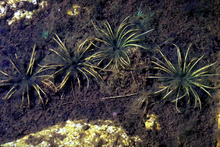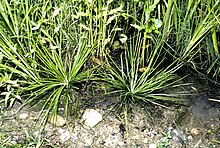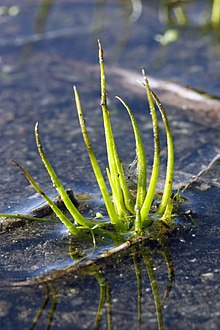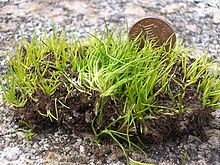Bream herbs
| Bream herbs | ||||||||||||
|---|---|---|---|---|---|---|---|---|---|---|---|---|

|
||||||||||||
| Systematics | ||||||||||||
|
||||||||||||
| Scientific name of the family | ||||||||||||
| Isoetaceae | ||||||||||||
| Dumort. | ||||||||||||
| Scientific name of the genus | ||||||||||||
| Isoetes | ||||||||||||
| L. |
The bream herbs ( Isoetes , also written Isoëtes ) are the only recent genus of the plant order Brachsenkraut variety (Isoetales) within the class Bärlapppflanze (Lycopodiopsida). These perennial herbaceous plants with a bulbous stem grow submerged in water or on moist soil and occur almost all over the world.
description
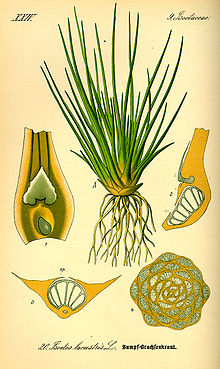
(A) Whole plant - (1) Leaf base with sporangium at the base and ligule above - (2) Longitudinal section and (3) Cross section of the leaf base with the chambered sporangium - (4) Cross section through the base of the shoot
Vegetative characteristics
The bream herbs grow as perennial herbaceous plants and have a rush-like habit ; this is where they differ from all other bear moss plants.
Stem axis
The bream herbs have a short, fleshy, upright tuber as the stem axis . The stem axis is rarely branched once or twice dichotomously , these species were previously placed in their own genus Stylites . The tuber grows underground. The meristem at the top is suppressed. The tuber is two-, more rarely three-lobed, rather spherical to horizontally spindle-shaped .
The stem axis has a secondary growth in thickness . This takes place via a cambium zone consisting of more or less isodiametric cells, which arise in the tuber around the primary conductive tissue. This cambium forms little xylem and phloem , but a lot of bark tissue. In types of temperate zones, the cambium is seasonally active. Simultaneously with the formation of new tissue, the outermost tissue zone is shed together with the leaf remnants and roots. The ripe tuber therefore maintains a constant size.
The primary xylem consists of more or less isodiametric tracheids . At the bottom of the stele they form an anchor-shaped branch that lies in the same plane as the transverse column on the underside of the tuber. The tissue released inwards by the cambium differentiates itself into a mixture of tracheids, sieve cells and parenchyma . The tissue released to the outside is parenchymatic. An endodermis delimiting the conductive tissue is absent in the bream herbs.
root
The lower meristem is also suppressed and lies in the transverse cleft of the tuber. The roots arise from the underside of the tuber near the meristem. The roots have a single vascular bundle , which is surrounded by a two-layered bark: the outer one is quite resistant, the inner one consists of delicate-walled cells and numerous air-filled cell spaces.
leaves
Each of the side branches has a tuft of quill- like leaves ( microphylls ) at the top . The microphylls carry a ligula . The leaves are 1 to 70 centimeters long and in young plants are initially in two rows ( distich ), this soon turns into a tight spiral around the meristem.
The leaves are traversed by a single vascular bundle, which is often very thin. There are four air channels around the vascular bundle, which are interrupted at intervals by transverse walls. The air ducts are particularly pronounced in aquatic plants. The leaf base is broadened and free of chlorophyll . The bases overlap and form a tuft.
Multiplication and Gametophytes
The Isoëtales are heterosporous . The sporophylls do not differ significantly from sterile leaves. The leaves formed first in the growing season form megasporangia , the later microsporangia, the leaves formed last are often sterile. The sporangium arises between the ligula and the axis. Part of the tissue inside the sporangium remains sterile and forms partitions, so-called trabeculae. The mature sporangium is enclosed by a thin covering, the velum. The velum arises below the ligula and grows over the sporangium, leaving a central opening, the foramen, free.
In a megasporangium, around 100 mega spores with a size of 0.2 to almost 1 millimeter are formed. Up to a million microspores with a diameter of up to 40 micrometers are formed in the microsporangia. The microspores are monolet, have only one scar of separation, while the megaspores are trilet, have a three-rayed scar. Isoetes is thus the only recent genus of bear moss plants that form monolet spores, but also one of the very few plants that form both monolet and triple spores on an individual.
The spores are only released in the course of the decomposition of the sporophyll. Germination and development of the gametes are similar to that of the moss ferns . In contrast to this, the male gametophyte remains completely in the spore (is endospor). Four spermatozoids emerge from the single antheridium , which, in contrast to those of the moss ferns and Lycopodium, are much flagellated . The spermatozoids are released by tearing open the microspore wall. The female gametophyte is similar to that of the moss fern. The cell formation extends far into the interior of the spores, there is no diaphragm as in many moss ferns. The development of the female gametophyte is initially endospore, but the growing gametophyte tears open the megaspore along the three-rayed scar. However, it does not form chlorophyll. The archegonia also resemble those of the moss fern, but their neck consists of four layers of cells, not two.
The first division of the zygote is slightly crooked. No suspensor is formed, but the embryo is still endoscopic, as the outer cell forms the foot, the entire remaining embryo is derived from the remaining inner cell. The embryo rotates as it grows so that it finally points to the top of the gametophyte. It breaks out of the gametophyte, the young plant remains for some time surrounded by a sheath made of gametophyte tissue.
From triploid species of Isoetes is apogamy known. Asexual reproduction occurs frequently by means of bud formation instead of the sporangium.
Systematics and distribution
Isoetes is the only recently occurring genus of the order Isoëtales . The species that used to be classified as Stylites are now classified as Isoetes.
The genus Isoetes includes about 150 species. Only the sea bream ( Isoetes lacustris ) and the hedgehog spore bream ( Isoetes echinospora ) are rarities in Central Europe. The following species exist in Europe, North Africa and the Middle East:
- Isoetes anatolica Prada & Rolleri : It occurs in Turkey .
- Isoetes azorica Durieu ex Milde : This endemic occurs only in the Azores .
- Isoetes boryana Durieu : It occurs only in France .
- Isoetes creussensis Lazare & S.Riba : It occurs in Spain and Andorra .
- Isoetes duriei Bory : It is common in the Mediterranean .
- Hedgehog bream ( Isoetes echinospora Durieu ): It is common in Europe , East Asia , North America and Greenland and is a neophyte in Siberia .
- Isoetes fluitans M.I.Romero : It occurs in Spain.
- Isoetes gymnocarpa (Gennari) A. Brown (Syn .: Isoetes sicula Tod. , Isoetes subinermis (Gennari) Cesca & Peruzzi , Isoetes histrix var. Subinermis Motelay & Vendryès ): It occurs in Italy , Sardinia , Sicily , Greece , Crete , in the Aegean Sea and Turkey .
- Isoetes heldreichii Wettst. : It only occurs in Greece.
- Isoetes histrix Bory : It is common in the Mediterranean and Western Europe.
- Sea bream ( Isoetes lacustris L. ): It is common in Europe, Western Siberia , Japan , North America, and Greenland.
- Isoetes libanotica Musselman, Bolin & RDBray : It wasfirst describedin 2011 from Lebanon .
- Isoetes malinverniana Cesati & De Not. : This endemic occurs only in north-western Italy .
- Isoetes olympica A.Braun : It occurs only in the Middle East .
- Isoetes sabatina Troia & Azzella : It occurs in Italy .
- Isoetes setacea Lam. (Syn .: Isoetes delilei Rothm. ), Occurs only in France, Spain and Portugal .
- Isoetes todaroana Troìa & Raimondo (Syn .: Isoetes iapygia Ernandes & al. ): It occurs in Italy, Sicily and Greece.
- Isoetes velata A.Braun (Syn .: Isoetes boryana Durieu ) ,: The several subspecies occur in the western Mediterranean and in Portugal and are sometimes used as aquarium plants.
Other types are (selection):
- Isoetes andicola (Amstutz) LDGómez (Syn .: Stylites andicola Amstutz ), occurs in the Andes of South America.
- Isoetes biafrana Arthur Hugh Alston : She is only known from the Moka and Oku lakes .
- Isoetes cubana Engelm. ex Baker
- Isoetes engelmannii A.Braun : It is common in the United States.
- Isoetes japonica A. Brown
- Isoetes melanospora Engelm. : It occurs in Georgia and South Carolina .
- Isoetes mexicana Underw.
- Isoetes sinensis Palmer : It occurs in the Chinese provinces of Anhui, Guangxi, Jiangsu and Zhejiang.
- Isoetes tegetiformans Rury : This endemic occurs only in Georgia.
- Isoetes viridimontana M.A.Rosenthal & WCTaylor : This endemic wasfirst describedin 2014 from Vermont .
literature
- Peter R. Bell, Alan R. Hemsley: Green Plants. Their Origin and Diversity. 2nd Edition. Cambridge University Press, Cambridge 2000, ISBN 0-521-64109-8 , pp. 159-161. (Section description)
- W. Carl Taylor, Neil T. Luebke, Donald M. Britton, R. James Hickey, Daniel F. Brunton: Isoetaceae. In: Flora of North America Editorial Committee (Ed.): Flora of North America North of Mexico . Volume 2: Pteridophytes and Gymnosperms . Oxford University Press, New York / Oxford a. a. 1993, ISBN 0-19-508242-7 , pp. 64 (English, online ). (Section description)
- Anthony Clive Jermy, John Robert Akeroyd: Isoetes L. In: TG Tutin, NA Burges, AO Chater, JR Edmondson, VH Heywood, DM Moore, DH Valentine, SM Walters, DA Webb (Eds.): Flora Europaea . 2nd, revised edition. Volume 1: Psilotaceae to Platanaceae . Cambridge University Press, Cambridge / New York / Melbourne 1993, ISBN 0-521-41007-X , pp. 6–7 (English, limited preview in Google Book Search).
Individual evidence
- ^ W. Carl Taylor, Neil T. Luebke, Donald M. Britton, R. James Hickey, Daniel F. Brunton: Isoetaceae. In: Flora of North America Editorial Committee (Ed.): Flora of North America North of Mexico . Volume 2: Pteridophytes and Gymnosperms . Oxford University Press, New York / Oxford a. a. 1993, ISBN 0-19-508242-7 , pp. 64 (English, online ).
- ↑ a b Michael Hassler, Bernd Schmitt: Checklist of Ferns and Lycophytes of the World. Version 2.1: Isoetes . ( Page no longer available , search in web archives ) Info: The link was automatically marked as defective. Please check the link according to the instructions and then remove this notice. Karlsruhe 2011.
- ^ Siegmund Seybold (Ed.): Schmeil-Fitschen interactive . CD-ROM, version 1.1. Quelle & Meyer, Wiebelsheim 2002, ISBN 3-494-01327-6 .
- ↑ Werner Greuter , Hervé-Maurice Burdet , Guy Long (eds.): Med-Checklist. A critical inventory of vascular plants of the circum-Mediterranean countries . Vol. 1: Pteridophyta (ed. 2), Gymnospermae, Dicotyledones (Acanthaceae - Cneoraceae) . Conservatoire et Jardin Botanique, Genève 1984, ISBN 2-8277-0151-0 ( online ).
- ↑ a b c d e f Maarten Christenhusz, Eckhard von Raab-Straube: Lycopodiophytina. Isoetes. In: Euro + Med Plantbase - the information resource for Euro-Mediterranean plant diversity. Berlin 2013.
- ↑ Carmen Prada, Cristina H. Rolleri: A new species of Isoetes (Isoetaceae) from Turkey, with a study of microphyll intercellular pectic protuberances and their potential taxonomic value. In: Botanical Journal of the Linnean Society. Volume 147, No. 2, 2005, pp. 213-228, DOI: 10.1111 / j.1095-8339.2005.00362.x .
- ^ A b Walter Erhardt, Erich Götz, Nils Bödeker, Siegmund Seybold: The great pikeperch. Encyclopedia of Plant Names. Volume 2. Types and varieties. Eugen Ulmer, Stuttgart (Hohenheim) 2008, ISBN 978-3-8001-5406-7 .
- ↑ MI Romero Buján, J. Amigo, P. Ramil: Isoetes fluitans sp. nov .: the identity of Spanish plants of 'I. longissimum '. In: Botanical Journal of the Linnean Society. Volume 146, No. 2, 2004, pp. 231-236, DOI: 10.1111 / j.1095-8339.2004.00315.x .
- ↑ Jay F. Bolin, Rebecca D. Bray, Lytton John Musselman: A New Species of Diploid Quillwort (Isoetes, Isoetaceae, Lycophyta) from Lebanon. In: Novon. Volume 21, No. 3, 2011, pp. 295-298, DOI: 10.3417 / 2010028 .
- ↑ Angelo Troia, MM Azzella: Isoëtes sabatina (Isoëtaceae, Lycopodiophyta), a new aquatic species from central Italy. In: Plant Biosystems. Volume 147, No. 4, 2013, pp. 1052-1058, DOI: 10.1080 / 11263504.2013.782902 .
- ↑ Angelo Troia, M. Raimondo: Isoetes todaroana (Isoëtaceae, Lycopodiophyta), a New Species from Sicily (Italy). In: American Fern Journal. Volume 99, No. 4, 2009, pp. 238-243, DOI: 10.1640 / 0002-8444-99.4.238 .
- ^ MI Romero, C. Real: A morphometric study of three closely related taxa in the European Isoetes velata complex. In: Botanical Journal of the Linnean Society. Volume 148, No. 4, 2005, pp. 459-464, DOI: 10.1111 / j.1095-8339.2005.00419.x .
- ↑ Christel Kasselmann : aquarium plants. Ulmer Verlag, Stuttgart 1995; 2nd, revised and expanded edition 1999, ISBN 3-8001-7454-5 , p. 318 ( Isoetes velata A. Braun var. Sicula Gennari, Veiled Brachsenkraut ).
- ↑ Isoetes biafrana on Natural History Museum (English).
- ^ Li-Bing Zhang, W. Carl Taylor: Isoetaceae. and Isoëtes L. , pp. 35–36 - the same text online as the printed work , In: Wu Zheng-yi, Peter H. Raven, Deyuan Hong (ed.): Flora of China. Volume 2-3: Lycopodiaceae through Polypodiaceae. Science Press and Missouri Botanical Garden Press, Beijing and St. Louis 2013, ISBN 978-1-935641-11-7 .
